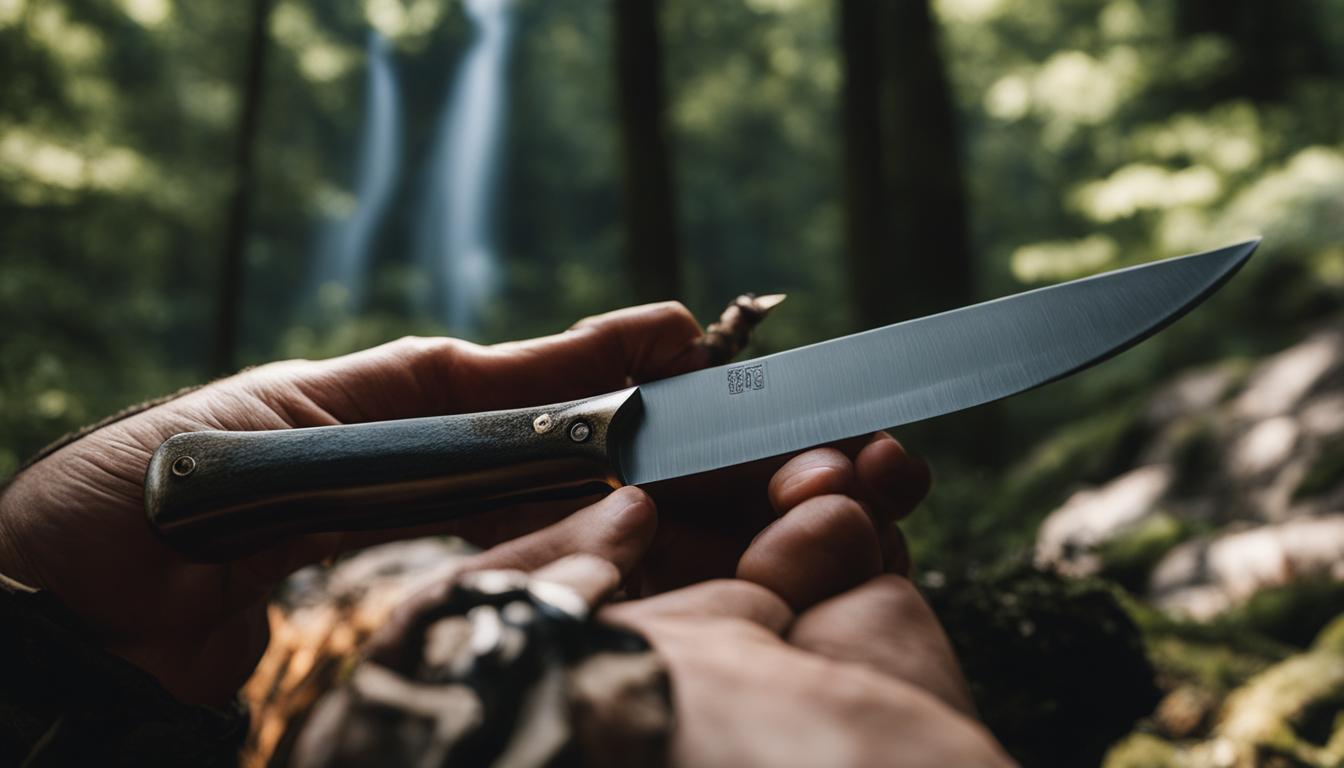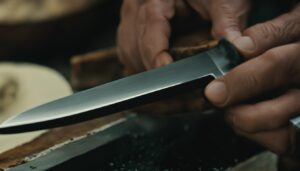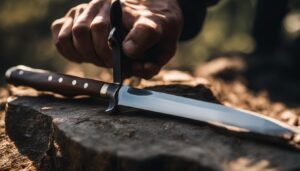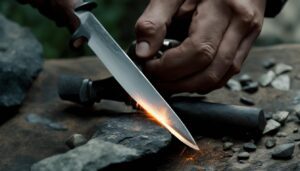Hunting knives are essential tools for hunters, used for various tasks such as skinning, dressing game, and preparing food. However, a dull knife can hinder performance and pose risks in the wilderness. Therefore, having a reliable hunting knife sharpening service is crucial. This article will provide all the information needed to understand the importance of sharpening hunting knives and how to keep them in top condition for a safe and efficient wilderness adventure.
Key Takeaways:
- Regular sharpening of hunting knives is essential for optimal performance and safety during wilderness adventures.
- A dull knife can impede tasks, be time-consuming, and increase the risk of accidents.
- Choosing the right sharpening tools, such as sharpening stones or honing rods, is crucial for obtaining razor-sharp blades.
- Proper knife maintenance, including cleaning, checking for damage, and determining the correct sharpening angle, is necessary before sharpening.
- Using a whetstone to sharpen hunting knives involves applying light pressure and using a sweeping motion on both sides of the blade.
Understanding the Importance of Knife Sharpening for Hunting
A sharp hunting knife is essential for a successful hunt and other outdoor activities. Whether you are skinning game, preparing food, or performing various tasks in the wilderness, having a blade that is razor-sharp can make all the difference. A dull knife not only makes these tasks more difficult and time-consuming but also increases the risk of accidents and injuries. That is why knife sharpening is a crucial skill that every hunter should master.
Sharpening a hunting knife involves restoring the blade’s sharpness by removing the dull edges and creating a new, keen edge. There are various methods and tools available for sharpening, such as sharpening stones, honing rods, and electric sharpeners. The choice of method depends on personal preference and the type of hunting knife you have.
When sharpening a hunting knife, it’s important to maintain a consistent sharpening angle. Different types of blades require different angles for optimal sharpness. The general rule of thumb is to maintain a 20-degree angle, but it’s always recommended to check the manufacturer’s guidelines or use a coin trick to determine the correct angle for your specific knife. By consistently sharpening your hunting knife and keeping it in top condition, you can enhance your performance in the field and ensure a safe and enjoyable outdoor experience.
Choosing the Right Sharpening Tools for Hunting Knives
When it comes to sharpening hunting knives, having the right tools is crucial for achieving optimal results. There are several options available, each with its own advantages and considerations. Let’s explore the most common sharpening tools used for hunting knives.
Sharpening Stone
A sharpening stone, also known as a whetstone, is a popular choice for many hunters. It requires the application of oil or water to provide lubrication and enhance the sharpening process. Sharpening stones offer versatility and allow for complete control over the sharpening angle. They are available in various grits, allowing hunters to start with a coarser grit to remove nicks and damage, and then progress to finer grits for a polished, razor-sharp edge.
Honing Rod
A honing rod is another effective tool for maintaining the sharpness of hunting knives. It is used to realign the edge of the blade and remove any burrs that may have formed during use. Honing rods are suitable for all types of hunting knives and are easy to use. They are particularly useful for quick touch-ups and routine maintenance to ensure the blade remains sharp between sharpenings.
Electric Sharpener
For hunters looking for convenience and efficiency, an electric sharpener is a great option. Electric sharpeners feature rotating abrasive belts or discs that quickly remove material from the blade to create a sharp edge. However, it’s important to use an electric sharpener properly to prevent removing too much material and potentially damaging the blade. Follow the manufacturer’s instructions and exercise caution when using an electric sharpener.
Guided Sharpening System
For beginners or those seeking precision and consistency in their sharpening technique, a guided sharpening system is an excellent choice. These systems usually include a clamp or guide that helps maintain a consistent angle throughout the sharpening process. Guided sharpening systems are easy to use and provide excellent results, making them ideal for hunters who are new to sharpening or prefer a more guided approach.
| Sharpening Tool | Advantages | Considerations |
|---|---|---|
| Sharpening Stone | Versatile Complete control over sharpening angle Available in various grits |
Requires oil or water for lubrication May take more time and practice to master |
| Honing Rod | Suitable for all types of hunting knives Easy to use Quick touch-ups and maintenance |
Does not remove significant material Not suitable for sharpening severely dull blades |
| Electric Sharpener | Quick and efficient sharpening Convenient to use |
Potential to remove too much material Requires caution and proper technique |
| Guided Sharpening System | Consistent and precise sharpening Easy to use Great for beginners |
May be less versatile than other options Requires the use of a clamp or guide |
A sharp knife is a hunter’s best friend. It’s important to choose the right sharpening tools based on your preferences and needs. Sharpening stones and honing rods offer versatility and control, while electric sharpeners provide convenience. If you’re new to sharpening or prefer a guided approach, a guided sharpening system is a great option. Whichever tool you choose, remember to follow proper sharpening techniques and maintain the integrity of your hunting knife for a safe and successful wilderness adventure.
Preparing Your Hunting Knife for Sharpening
Before sharpening your hunting knife, it’s important to properly prepare the blade to ensure optimal results. There are a few key steps to follow to ensure the best sharpening experience.
Step 1: Cleaning the Blade
Start by thoroughly cleaning the blade of your hunting knife. Use a mild detergent and warm water to remove any dirt, debris, or residue. Scrub gently with a soft brush or cloth to avoid scratching the blade. Rinse the knife and dry it thoroughly with a clean towel.
Step 2: Checking for Damage
Inspect the blade carefully for any signs of damage, such as chips, nicks, or bends. If you notice any damage, it’s important to address it before sharpening. Use a file or sharpening stone to smooth out any rough or damaged areas. This will ensure that the blade is in the best condition for sharpening.
Step 3: Determining the Sharpening Angle
The sharpening angle is a crucial factor in achieving a razor-sharp edge. If the manufacturer’s recommendations are not available, you can use a simple coin trick to determine the angle. Place a coin on the cutting edge of the blade and raise the spine of the knife until the coin is just about to fall off. This angle will give you a good starting point for sharpening.
By following these steps, you can properly prepare your hunting knife for sharpening. Cleaning the blade, checking for damage, and determining the sharpening angle are all essential for achieving the best results.
| Step | Description |
|---|---|
| Step 1: | Cleaning the Blade |
| Step 2: | Checking for Damage |
| Step 3: | Determining the Sharpening Angle |
Sharpening Hunting Knives with a Whetstone
One of the most effective and commonly used methods for sharpening hunting knives is using a sharpening stone, also known as a whetstone. This traditional sharpening tool provides excellent control and precision, allowing you to achieve a razor-sharp edge on your blade.
To begin sharpening your hunting knife with a whetstone, make sure you have a clean and flat surface to work on. Place a damp cloth or rubber mat under the stone to prevent it from slipping. Lubricate the stone with water or honing oil to ensure smooth and consistent sharpening.
I find that using a sharpening angle guide helps maintain a consistent angle throughout the sharpening process. This ensures that both sides of the blade are sharpened evenly, resulting in a balanced and sharp edge.
Hold the knife firmly and position the blade against the stone at the desired sharpening angle. This angle will depend on the type of knife and your personal preference. Using light pressure, move the blade back and forth in a sweeping motion along the entire length of the stone. Repeat this process on the other side of the blade, maintaining the same angle and pressure.
Tips for Using a Whetstone:
- Start with a coarser grit to remove any nicks or damage on the blade, then gradually move to a finer grit for a polished edge.
- Keep the stone wet during sharpening to prevent overheating and ensure smoother sharpening.
- Alternate sides after every few strokes to maintain an even edge.
- Check your progress by lightly running your finger along the edge. A sharp blade should feel smooth and catch on your nail.
After sharpening with a whetstone, it’s important to remove any burrs and polish the edge for optimal cutting performance. Use a honing rod to lightly run along both sides of the blade, applying minimal pressure. This step helps align the edge and remove any remaining imperfections, resulting in a finely sharpened hunting knife.
Remember, maintaining the sharpness of your hunting knife is an ongoing process. Regular sharpening with a whetstone, along with proper blade care and maintenance, will ensure that you always have a reliable and sharp tool for your hunting adventures.
| Advantages of Sharpening with a Whetstone | Disadvantages of Sharpening with a Whetstone |
|---|---|
|
|
With proper technique and practice, sharpening your hunting knife with a whetstone can be a rewarding and satisfying experience. The control and precision offered by this method allow you to achieve a finely sharpened blade that will enhance your hunting performance and ensure your safety in the wilderness.
Keeping Your Hunting Knife Sharp for Longer Periods of Time
Proper maintenance and care are essential to keep your hunting knife sharp for extended periods. By following a few simple practices, you can ensure that your blade remains in optimal condition and ready for any wilderness adventure. Here are some key tips for maintaining the sharpness of your hunting knife:
Regular Use of a Honing Rod
Using a honing rod regularly is one of the best ways to maintain the sharp edge of your hunting knife between sharpenings. A honing rod helps align the microscopic teeth on the blade, keeping them in optimal cutting condition. To use a honing rod, hold the knife at a 20-degree angle and run the blade along the rod in a sweeping motion. Repeat this process a few times on each side of the blade to ensure even sharpening. By regularly honing your hunting knife, you can extend the time between sharpening sessions.
Proper Storage
How you store your hunting knife can significantly impact its sharpness. Always make sure to clean and dry the blade before storing it. Moisture can cause rust and dull the edge of the blade. Store the knife in a dry place, away from humidity and extreme temperatures. Consider using a knife sheath or a blade cover to protect the edge from accidental damage while in storage or during transportation.
Blade Care
Proper blade care is crucial for maintaining the sharpness of your hunting knife. Avoid using the knife for tasks it’s not intended for, as this can cause unnecessary wear and tear on the blade. Additionally, clean the blade thoroughly after each use to remove any dirt, debris, or residue that could affect its performance. Avoid abrasive cleaning agents that can damage the blade or handle. Instead, use mild soap and warm water, drying the blade thoroughly afterward.
Regular Sharpening
Even with proper maintenance, hunting knives will eventually require sharpening. Regular sharpening ensures that your blade is always in optimal cutting condition. Use a sharpening stone or an electric sharpener to restore the sharp edge of the blade. Follow the manufacturer’s instructions or seek professional guidance to ensure you are sharpening your knife correctly. Remember to maintain a consistent angle and apply light pressure when sharpening to avoid removing too much material from the blade.
By incorporating these practices into your knife maintenance routine, you can keep your hunting knife sharp and ready for action on your next wilderness adventure.
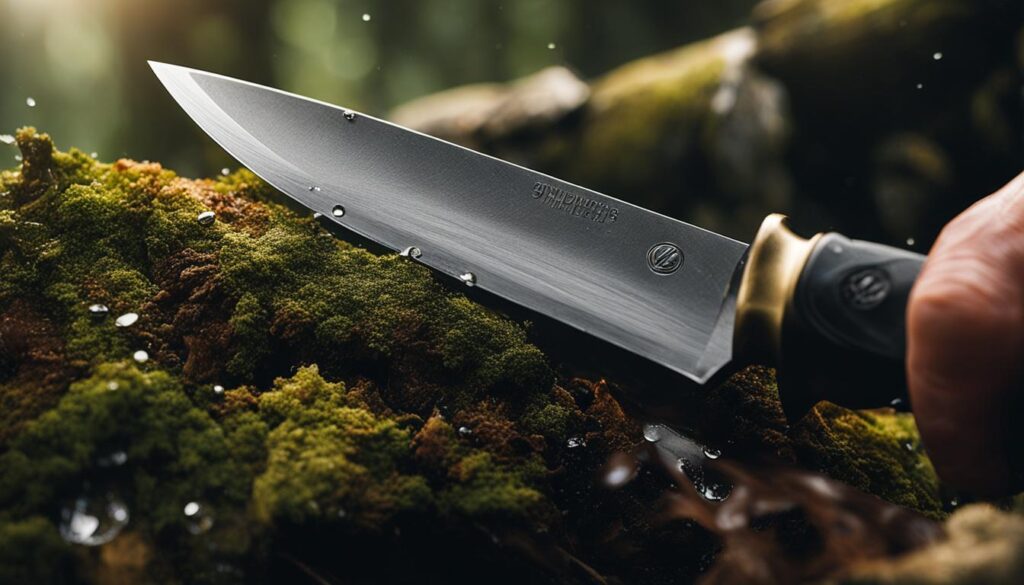
Conclusion
In conclusion, maintaining the sharpness of your hunting knife is crucial for a successful wilderness adventure. By utilizing a reliable hunting knife sharpening service, you can ensure that your blades remain razor sharp, enhancing their performance in the field.
With consistently sharp blades, you can tackle tasks such as skinning, dressing game, and preparing food with ease and efficiency. Dull blades not only make these tasks more difficult but also pose safety risks in the wilderness. By prioritizing blade sharpness, you can maintain optimal performance and reduce the likelihood of accidents.
Remember, regular maintenance and sharpening are key to preserving the sharpness of your hunting knife. By following the recommended practices outlined in this article, including choosing the right sharpening tools and techniques, you can maintain blade sharpness and ensure your hunting knife performs at its best for years to come.
FAQ
Why is it important to sharpen hunting knives?
Sharpening hunting knives is essential for optimal performance, efficiency, and safety during outdoor activities such as hunting. A sharp knife makes tasks easier, faster, and reduces the risk of accidents.
What tools are available for sharpening hunting knives?
There are various sharpening tools to choose from, including sharpening stones (whetstones), honing rods, electric sharpeners, pull-through sharpeners, and guided sharpening systems. Each tool has its advantages and disadvantages, so it’s important to choose the one that suits your needs.
How do I prepare my hunting knife for sharpening?
Before sharpening your hunting knife, it’s important to clean the blade from dirt and debris. Check for any nicks or damage that need to be smoothed out. Determine the correct sharpening angle, either by referring to the manufacturer’s recommendations or using a coin trick. Once the angle is known, you can proceed with sharpening.
What is the process for sharpening hunting knives with a whetstone?
Sharpening hunting knives with a whetstone involves holding the stone securely and placing the knife blade at the desired sharpening angle. Apply light pressure while moving the blade back and forth in a sweeping motion. Repeat this process on both sides of the blade, gradually increasing the pressure. Finish by using a honing rod to remove any remaining burrs and polish the edge.
How can I keep my hunting knife sharp for longer periods of time?
To keep your hunting knife sharp, use a honing rod regularly to maintain the edge between sharpenings. Store the knife in a dry place away from humidity and extreme temperatures. Avoid using the knife for tasks it’s not intended for. Regularly sharpen the blade using a sharpening stone or an electric sharpener.
